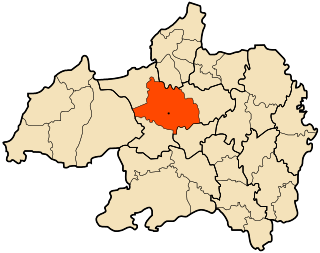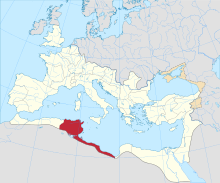
Parthenia was a Roman–Berber town in the former Roman province of Mauretania Sitifensis, the easternmost part of ancient Mauretania. It was located in what is now northern Algeria.

Gafsa, originally called Capsa in Latin, is the capital of Gafsa Governorate of Tunisia. It lends its Latin name to the Mesolithic Capsian culture. With a population of 105,264, Gafsa is the 9th-largest Tunisian city.

The Councils of Carthage, or Synods of Carthage, were church synods held during the 3rd, 4th, and 5th centuries in the city of Carthage in Africa. The most important of these are described below.

The name Early African Church is given to the Christian communities inhabiting the region known politically as Roman Africa, and comprised geographically within the following limits, namely: the Mediterranean littoral between Cyrenaica on the east and the river Ampsaga on the west; that part of it that faces the Atlantic Ocean being called Mauretania. The evangelization of Africa followed much the same lines as those traced by Roman civilization.

Thelepte was a city in the Roman province of Byzacena, now in western Tunisia. It is located 5 km from the modern town of Fériana, near the border with Algeria, at around 34°58′33″N8°35′38″E.
Macri, or perhaps Macras, was a town and bishopric in the Roman province of Mauretania Sitifensis.

Abitinae was a town in the Roman province of Africa Proconsularis and is famed for the Martyrs of Abitinae.
Victor Vitensis was an African bishop of the Province of Byzacena. His importance rests on his Historia persecutionis Africanae Provinciae, temporibus Genserici et Hunirici regum Wandalorum.
The Notice of the Provinces and Cities of Africa is a Byzantine-era document listing the bishops and sees in the Roman provinces of North Africa. The cause of its preparation was the summoning of the episcopate to Carthage on 1 February 484 by the Arian king of the Vandals, Huneric (477–84).

Medjana is a town and commune (municipality) in Bordj Bou Arréridj Province, Algeria. It is the (approximative) location the Ancient city and bishopric Vardimissa, which remains a Latin Catholic titular see.

Djinet, the classical Cissi, is a port town and commune in the Bordj Menaïel District of Boumerdès Province, Algeria, east of the mouth of the Isser River and around Cape Djinet. As of 2008, the population of the municipality is 21,966.

Capra was an ancient Roman–Berber town in the province of Mauretania Caesariensis. The civitas was located in the present-day area of Béni Mansour and Béni Abbès, Algeria. It was a bishopric in the Roman Catholic Church.

Avitta Bibba was a town in the Roman province of Africa Proconsularis. The town is tentatively identified with ruins at Henchir-Bour-Aouitta in Tunisia.
The episcopal see of Carthage, the city restored to importance by Julius Caesar and Augustus, in which Christianity was firmly established by the 2nd century, was the most important in the whole of Roman Africa and continued as a residential see even after it had fallen to the Muslim conquest, until the start of the second millennium.

Simminensis is an ancient and titular episcopal see of the Roman province of Africa Proconsularis in modern Tunisia, and a suffragan diocese of the Archdiocese of Carthage.
Saint Fiorenzo or Florenzi was a North African bishop during the latter Roman Empire, venerated as a saint by the Catholic Church. He is known to history from hagiographies and the Notitia Provinciarum et Civitatum Africae Bishop Florients He was Bishop of Simminensis, 30 km east of Carthage in Roman North Africa. He suffered the persecution at the hand of the Arian, Vandal king Huneric for his role in the Council of Carthage of 484 where he supported, the Catholic position rejecting Arianism. He was Exiled to Corsica and forced to hard labor, there continued his apostolic work until his death. Also according to tradition, he was initially buried in the town that bears his name, San Fiorenzo. In 760AD the bishop of Treviso Titian, through a vision, discovered his relics and transferred them to his city, placing them in the church of St. John the Baptist. Currently his remains are on display to the public worship in the Cathedral of Treviso.

Vazari-Didda or Vazari Didda) was an Ancient city and bishopric in Roman Africa, which remains a Latin Catholic titular see.
Secundus of Tigisis was an early church leader and primate of Numidia. He was a leading organiser of the early Donatist movement in Carthage.

Auzegera was a Roman-Berber town in the province of Africa Proconsularis and in late antiquity Byzacena. It was a Catholic Church diocese.

Melzi was a civitas (town) of the Roman Empire during late antiquity. It was also known as Meditanus.















